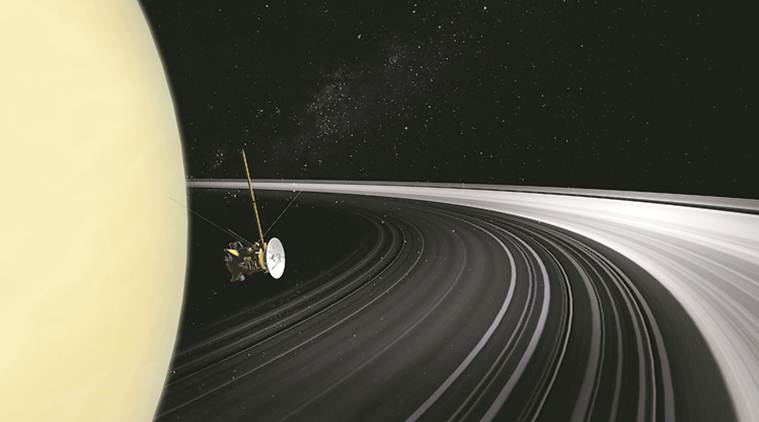This Word Means: Saturn’s rings
They are billions of years younger than Saturn itself, a new study finds. What else is known about them?
 Artist’s impression of Cassini crossing Saturn’s ring plane. (Photo: NASA/JPL-Caltech)
Artist’s impression of Cassini crossing Saturn’s ring plane. (Photo: NASA/JPL-Caltech)
Every illustration of Saturn, starting from school textbooks, shows it encircled by rings. Although the rings were first observed by telescopes centuries ago, knowledge about their formation and composition has been relatively slow coming. Now, a study published in Science suggests that the rings formed between 100 million and 10 million years ago, and are thus much younger than the 4.5-billion-year-old planet. How did scientists figure that out?
Much of what is known about the rings has come from four robotic spacecraft that have visited Saturn — Pioneer 11, Voyager 1, Voyager 2 and Cassini. The rings consist of a large number of small particles that orbit Saturn. They are about 400,000 km — equivalent to the distance between the Earth and the Moon — but are as little as 100 m thick, according to the NASA website.
There are many rings — perhaps 500 to 1,000 — and there are also gaps within them. Particles range in size from “too tiny to see” to “the size of a bus”, NASA says. Scientists believe the particles are icy snowballs or ice covered rocks.
Now, the study has concluded that Saturn hasn’t always had rings. The finding comes from Cassini’s final trajectory. In September 2017, the NASA spacecraft made its death plunge into Saturn’s atmosphere, and one of its last acts was to coast between the planet and its rings and let them tug it around, the University of California-Berkeley said in a press release.
Essentially, Cassini was acting as a gravity probe. From its final trajectory, scientists have made precise measurements leading to the finding about the age of the rings. Based on the strength of their gravitational pull, scientists made the first accurate estimate of the amount of material in Saturn’s rings — about 40% of the mass of Saturn’s moon Mimas, which itself is 2,000 times smaller than Ear’h’s moon. Calculations based on this led to the conclusion that the rings are relatively recent, having originated less than 100 million years ago and perhaps as recently as 10 million years ago.
Their young age puts to rest a long-running argument among planetary scientists, UC-Berkeley added. Some thought that the rings formed along with the planet itself, 4.5 billion years ago, from icy debris remaining in orbit after the formation of the Solar System. Others thought the rings were very young and that Saturn had, at some point, captured an object from the Kuiper belt or a comet and gradually reduced it to orbiting rubble.
- 01
- 02
- 03
- 04
- 05






































